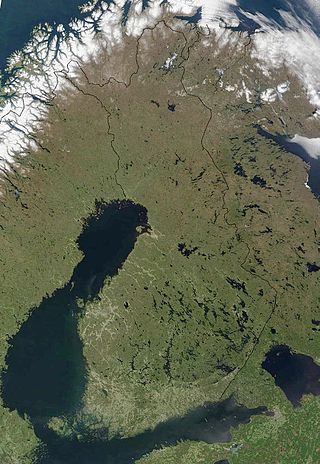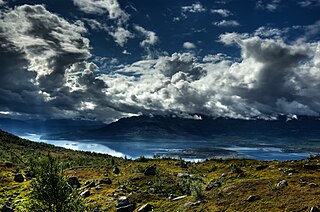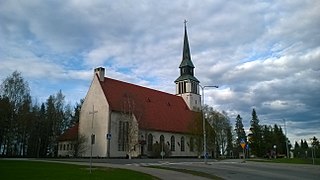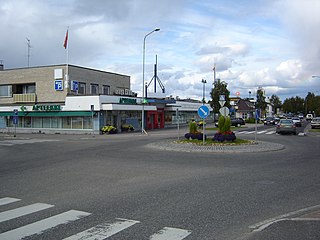
The geography of Finland is characterized by its northern position, its ubiquitous landscapes of intermingled boreal forests and lakes, and its low population density. Finland can be divided into three areas: archipelagoes and coastal lowlands, a slightly higher central lake plateau and uplands to north and northeast. Bordering the Baltic Sea, Gulf of Bothnia, and Gulf of Finland, as well as Sweden, Norway, and Russia, Finland is the northernmost country in the European Union. Most of the population and agricultural resources are concentrated in the south. Northern and eastern Finland are sparsely populated containing vast wilderness areas. Taiga forest is the dominant vegetation type.

The demographics of Finland is monitored by the Statistics Finland. Finland has a population of over 5.6 million people, ranking it 19th out of 27 within the European Union. The average population density in Finland is 19 inhabitants per square kilometre (49/sq mi), making it the third most sparsely populated country in Europe, after Iceland and Norway. Population distribution is extremely uneven, with the majority of the population concentrated in the southern and western regions of the country. The majority of the Finnish population - approximately 73% - lives in urban areas. Approximately 1.6 million, or almost 30%, reside solely in the Helsinki Metropolitan Area. Conversely, the Arctic Lapland region contains only two inhabitants per square kilometre (5.2/sq mi).

Norrbotten County is the northernmost county or län of Sweden. It is also the largest county by land area, almost a quarter of Sweden's total area. It shares borders with Västerbotten County to the southwest, the Gulf of Bothnia to the southeast, the counties of Nordland and Troms in Norway to the northwest, and Lapland Province in Finland to the northeast.

Rovaniemi is a city in Finland and the regional capital of Lapland. It is located near the Arctic Circle in the northern interior of the country. The population of Rovaniemi is approximately 65,000, while the sub-region has a population of approximately 69,000. It is the 17th most populous municipality in Finland, and the 12th most populous urban area in the country.

Västerbotten, known in English as West Bothnia or Westrobothnia, is a province (landskap) in the north of Sweden, bordering Angermannia, Lapland, North Bothnia, and the Gulf of Bothnia. It is known for the Westrobothnian cheese, (Västerbottensost) named after the province.

Kittilä is a municipality of Finland and a popular holiday resort.

Lapland is the largest and northernmost region of Finland. The 21 municipalities in the region cooperate in a Regional Council. Lapland borders the region of North Ostrobothnia in the south. It also borders the Gulf of Bothnia, Norrbotten County in Sweden, Finnmark County and Troms County in Norway, and Murmansk Oblast and the Republic of Karelia in Russia. Topography varies from vast mires and forests of the South to fells in the North. The Arctic Circle crosses Lapland, so polar phenomena such as the midnight sun and polar night can be viewed in Lapland.

Kemi is a town and municipality of Finland. It is located very near the city of Tornio and the Swedish border. The distance to Oulu is 105 kilometres (65 mi) to the south and to Rovaniemi is 117 kilometres (73 mi) to the northeast. It was founded in 1869 by a decree of the Emperor Alexander II of Russia because of its proximity to a deepwater port.

Salla is a municipality of Finland, located in Lapland. The municipality has a population of 3,343 (31 December 2023) and covers an area of 5,873.08 square kilometres (2,267.61 sq mi) of which 142.73 km2 (55.11 sq mi) is water. The population density is 0.58 inhabitants per square kilometre (1.5/sq mi).

Inari is Finland's largest municipality by area, with four official languages, more than any other in the country. Its major sources of income are tourism, service industry, and cold climate testing. With the Siida museum in the village of Inari, it is a center of Sami culture, widely known as the "capital of Sámi culture".

Kemijärvi is a town and municipality of Finland. It is located in Eastern Lapland sub-region.

Muonio is a municipality of Finland. The town is located in far northern Finland above the Arctic Circle on the country's western border, within the area of the former Lappi (Lapland) province. The municipality has a population of 2,324 and covers an area of 2,039.97 square kilometres (787.64 sq mi) of which 133.91 km2 (51.70 sq mi) is water. The population density is 1.22 inhabitants per square kilometre (3.2/sq mi).

Sodankylä is a municipality of Finland. It is located in the region of Lapland, and lies at the northern end of Highway 5 (E63) and along Highway 4 (E75). The Kitinen River flows near the center of Sodankylä. Its neighbouring municipalities are Inari, Kemijärvi, Kittilä, Pelkosenniemi, Rovaniemi, and Savukoski. The municipality has two official languages: Finnish and Northern Sami.

Lapland, also known by its Swedish name Lappland, is a province in northernmost Sweden. It borders Jämtland, Ångermanland, Västerbotten, Norrbotten, Norway and Finland. Nearly a quarter of Sweden's land area is in Lappland.

Haplogroup N (M231) is a Y-chromosome DNA haplogroup defined by the presence of the single-nucleotide polymorphism (SNP) marker M231.

During World War II, the Lapland War saw fighting between Finland and Nazi Germany – effectively from September to November 1944 – in Finland's northernmost region, Lapland. Though the Finns and the Germans had been fighting together against the Soviet Union since 1941 during the Continuation War (1941–1944), peace negotiations between the Finnish government and the Allies of World War II had been conducted intermittently during 1943–1944, but no agreement had been reached. The Moscow Armistice, signed on 19 September 1944, demanded that Finland break diplomatic ties with Germany and expel or disarm any German soldiers remaining in Finland.

Kemi-Tornio sub-region is a subdivision of Finnish Lapland and, since 2009, one of the sub-regions of Finland.

Northern Lapland is a subdivision of Finnish Lapland and one of the Sub-regions of Finland since 2009. It is the largest and most sparsely populated sub-region in Finland.

Fell Lapland is a subdivision of Finnish Lapland and one of the Sub-regions of Finland since 2009.

Koillismaa is a subdivision of Northern Ostrobothnia and one of the Sub-regions of Finland since 2009.

























